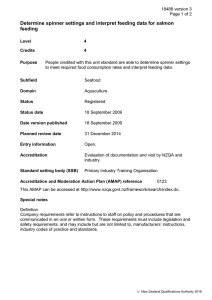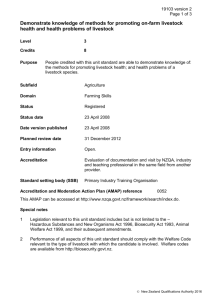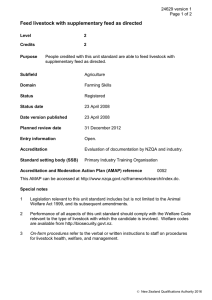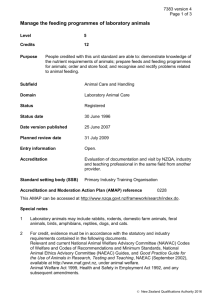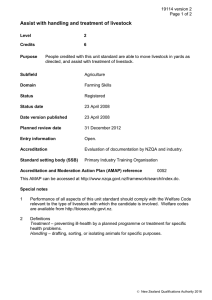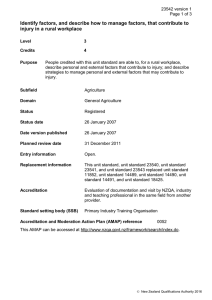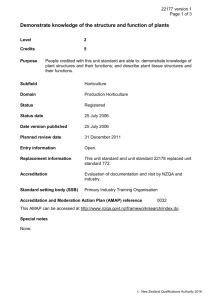Demonstrate knowledge of livestock feeding from a rural servicing business perspective
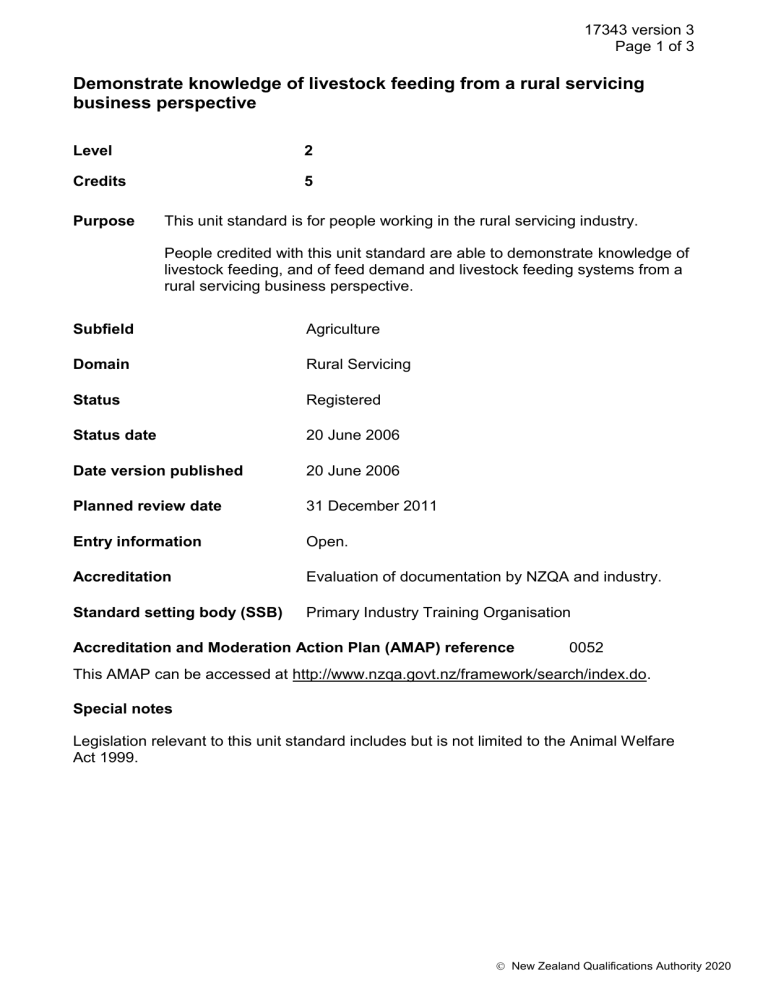
17343 version 3
Page 1 of 3
Demonstrate knowledge of livestock feeding from a rural servicing business perspective
Level 2
Credits 5
Purpose This unit standard is for people working in the rural servicing industry.
People credited with this unit standard are able to demonstrate knowledge of livestock feeding, and of feed demand and livestock feeding systems from a rural servicing business perspective.
Subfield Agriculture
Domain
Status
Status date
Date version published
Rural Servicing
Registered
20 June 2006
20 June 2006
Planned review date
Entry information
31 December 2011
Open.
Accreditation Evaluation of documentation by NZQA and industry.
Standard setting body (SSB) Primary Industry Training Organisation
Accreditation and Moderation Action Plan (AMAP) reference 0052
This AMAP can be accessed at http://www.nzqa.govt.nz/framework/search/index.do.
Special notes
Legislation relevant to this unit standard includes but is not limited to the Animal Welfare
Act 1999.
New Zealand Qualifications Authority 2020
17343 version 3
Page 2 of 3
Elements and performance criteria
Element 1
Demonstrate knowledge of livestock feeding from a rural servicing business perspective.
Performance criteria
1.1 Feed types suitable for livestock are described in terms of their seasonal use.
Range grass, clover, crops, supplements; evidence is required of at least two livestock species which may include but are not limited to
– beef cattle, dairy cattle, deer, pigs, sheep.
1.2 Changes in feed supply are described in relation to local conditions and seasons, quality and quantity, and the impact this may ha ve on farmers’ spending.
Element 2
Range grass, clover, crops, supplements.
Demonstrate knowledge of feed demand and livestock feeding systems from a rural servicing business perspective.
Performance criteria
2.1 Feed demand is described in terms of the requirements for classes of stock.
2.2
Range young stock, pregnant, lactating, dry stock.
Livestock feeding systems are described in terms of the farm systems in which they are most suitable for use.
Range three of – set stocking, rotational grazing, cell block grazing, supplementary feeding, crop residues, strip grazing, feedlot, feedpad.
2.3 Livestock feeding systems are described in terms of the implications for farmer expenditure.
Please note
Providers must be accredited by the Qualifications Authority, or an inter-institutional body with delegated authority for quality assurance, before they can report credits from assessment against unit standards or deliver courses of study leading to that assessment.
Industry Training Organisations must be accredited by the Qualifications Authority before they can register credits from assessment against unit standards.
New Zealand Qualifications Authority 2020
17343 version 3
Page 3 of 3
Accredited providers and Industry Training Organisations assessing against unit standards must engage with the moderation system that applies to those standards.
Accreditation requirements and an outline of the moderation system that applies to this standard are outlined in the Accreditation and Moderation Action Plan (AMAP). The
AMAP also includes useful information about special requirements for organisations wishing to develop education and training programmes, such as minimum qualifications for tutors and assessors, and special resource requirements.
Comments on this unit standard
Please contact the Primary Industry Training Organisation standards@primaryito.ac.nz if you wish to suggest changes to the content of this unit standard.
New Zealand Qualifications Authority 2020

